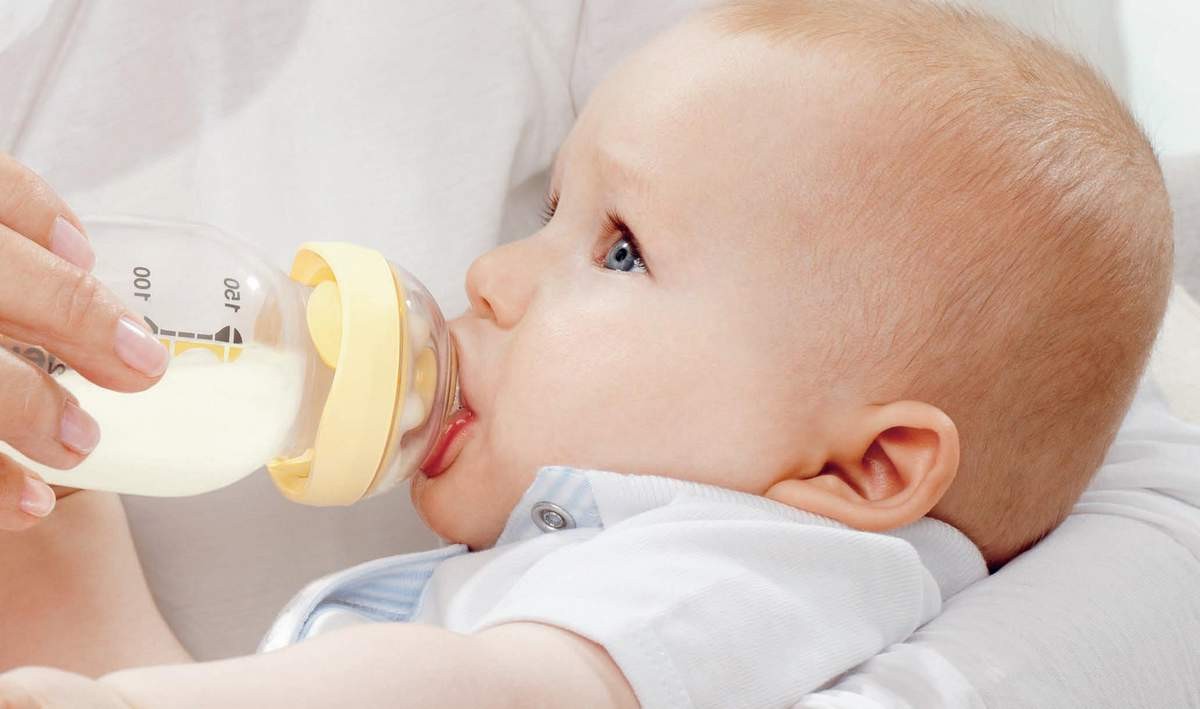
Food allergies in infants are quite dangerous. The statistics of such a disease are growing a threatening pace. The complexity of this disease lies in the fact that it is quite difficult to recognize in time. Bastard children cannot complain that they are concerned specifically. Often, any skin lesions are attributed to such an ailment.
The content of the article
- Symptoms of allergies to milk, protein
- How is the allergy to the mixture manifested?
- How does the allergy manifest to red?
- Causes of food allergies
- What products cause allergies in infants?
- What does inflammatory allergies look like?
- How to treat allergies in children?
- Diet of a nursing mother: what is possible and what is impossible
- Treatment of allergies with drugs
- Treatment of allergies in infants with folk remedies
- Allergies prevention in children up to a year
- Tips and reviews
- Video. Why does food allergy occur? - Dr. Komarovsky
Symptoms of allergies to milk, protein
According to the latest data, up to 8% of infants suffer from a negative reaction of the immune system to milk and milk protein. Such a disease is found in both children on breast and artificial feeding.
If the baby eats breasts, then the causes of negative reactions of the body are milk or dairy products that are used by the mother before feeding. In babies who are artificial feeding, allergens can enter the body from mixtures made on the basis of cow's milk.
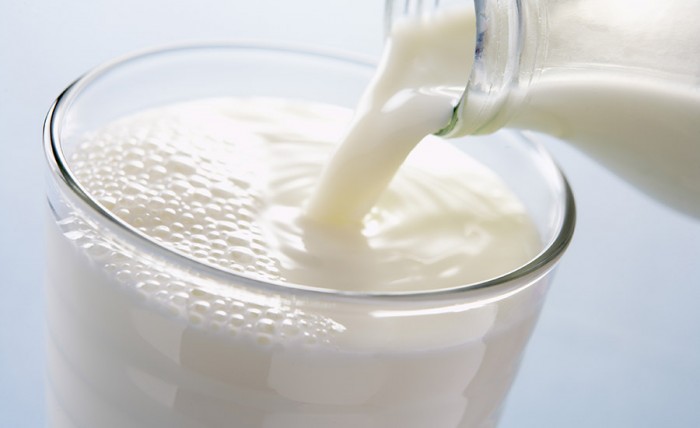
Casein can be a “provocateur” of such an ailment
Casein is a slowly digestible milk protein, which breaks down into amino acids in the body for a long time. Also often “include” the protective reactions of the body of the protein of the milk serum.
As a rule, in infants, negative reactions are detected almost immediately after the cow protein enters the body. Maximum a day after feeding.
The increased sensitivity of milk in infants is manifested:
- Red spots and other rashes on the skin
- Liquid stool with red
- Itching on the skin
- Frequent regurgitation during and after feeding
- Low weight gain
- Difficulty breathing in connection with the formation of mucus in the nose and mouth
- Flatulence and discomfort due to pain in the intestines
- Dehydration
In rare cases, such a reaction of the body to milk in infants can even lead to anaphylactic shock.
How is the allergy to the mixture manifested?
The most common symptoms of allergies to milk mixtures based on cow's milk are skin rashes. It can be urticaria, a rash around the mouth, on the cheekbones, neck and skin folds. At the same time, such manifestations of allergies can spread through the body and “take” other areas.

Over time, such skin lesions can be covered with crusts
- An allergy to the mixture can cause the appearance of weeping eczu on the skin. Children can comb them, which can aggravate such a defeat on the skin even more
- An allergy to a mixture for feeding an infant can manifest itself immediately after eating it or after 1-2 days
- Very often, such food allergies can cause breathing difficulty, cause cough and runny nose. It is such a reaction of the immune system to the milk protein, which is part of the mixture, is the most dangerous
- Allergies to the mixture can also cause a digestive system disorder
How does the allergy manifest to red?
Food irritants are especially dangerous for the body at an early age. In children, the reaction of the immune system is manifested almost instantly. Moreover, such a manifestation can cause very serious “conflicts” in the body.
Most often, eating red vegetables and fruits in food negatively affects the child’s health. Usually such an atypical reaction affects the skin. The child has rashes on the skin and itching. Also, the work of the stomach and intestines may be disturbed.
Important: if the child has such symptoms after eating red vegetables and fruits, then he needs to give an antihistamine and exclude such a product from the diet.
But, this treatment cannot be stopped by such an allergy. It is important not only to eliminate its consequences, but also to accurately identify an allergen that causes such reactions of the immune system and carry out its prolonged blocking.
Causes of food allergies

The main cause of food allergies in infants is a genetic predisposition to such a disease
Scientists have found that if one of the parents is allergic, then the likelihood that this violation of the immune system is transmitted to the child equal to 40%. If two, then 80%.
Food allergies are a disease that can prove itself at any age. But, the first year of the child’s life is the most dangerous. The thing is that his immune system has not yet been fully formed. And the new products that the child will take with food can cause its negative reaction. In this regard, cow's milk and other products containing animal protein are especially dangerous.
The reason for this problem may be associated with a lack of some enzymes:
- Proteases
- Lipases
- Amylase
Also, the composition of the intestinal microflora, which is not fully formed, may affect the causes of such a reaction of the child’s body. As well as increased permeability of the intestinal mucosa, which cannot restrain allergens for a long time. They quickly fall into the blood, creating dangerous consequences.
If the molecules that the child's body consider alien to fall into the blood, the immune system begins to fight with them, developing antibodies to them. The conflict of antibodies and "alien" molecules and leads to a negative reaction of the body.
Food allergies in a child can also be associated with:
- Smoking a woman during a child's gestation
- Fetal hypoxia
- Infectious diseases during pregnancy
- The use of some drugs during pregnancy
- The use of products containing a large number of allergens during the bearing of the child
- Early transition from breastfeeding to milk mixtures
- Incorrect introduction of complementary foods into the baby's diet
What products cause allergies in infants?
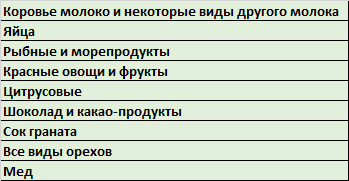
An allergic reaction may also appear when using products containing a small amount of allergens:
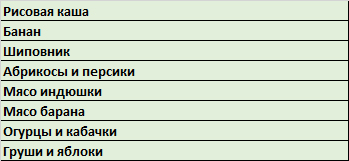
Products that have a potential danger to the child must be given to him with particular caution and monitor the reaction of his body.
What does inflammatory allergies look like?

Allergic rashes in a child aged one month is a normal reaction of his body
The thing is that it is at this age that the hormonal system of the mother ceases to support the baby's body. Which leads to the appearance of a red rash on the chest, back and face. It holds on the body as a rule for 3 weeks and disappears on its own.
Important: you need to understand that this is a completely normal reaction of a rebuilding child's body. It is impossible to process such rashes, the opportunity through them to bring an infection through them is great.
But, you need to be able to distinguish such a rash from allergic dermatitis. In addition to the appearance of a red rash, it is characterized by the following symptoms:
- Dryness and roughness of the skin, in the places of appearance of rash
- The appearance of skin itching, which greatly bothers the baby
- In rare cases, a child has a cough
- Its feces are stained green
Due to the individual nature of the body of each baby, others can be added to the above symptoms.
How to treat allergies in children?

Treatment of such an ailment consists in identifying and excluding an allergen from food
In order to cure food allergies in your child, you need to consult a doctor of a pediatrician, allergist and nutritionist.
Important: if allergies are manifested by bronchospasm caused by edema, then it is necessary to call an ambulance (call from the cellular “112”). Before the ambulance arrives, it is necessary to give the child an antihistamine. You can find out what you can give a child from a specialist, during an ambulance.
- If the baby eats breast milk, then the mother needs to exclude all dangerous products from food for 7-15 days. Especially those that contain: preservatives, emulsifiers, dyes and crystalline sugar
- The amount of milk and dairy products. The nursing mother in her diet should reduce
- In children on artificial feeding, allergies most often manifest on cow's milk proteins. When they are excluded from the baby's diet, the signs of this ailment should decrease, and the child will feel better
- The hypoallergenic diet should last for 1-3 months. After that, the diet of mom and child can be carefully increased by following the reaction of the baby
Important: negative manifestations of food allergies can be treated with antihistamines, adsorbents, skin creams and roll -on hormones.
Diet of a nursing mother: what is possible and what is impossible
If your baby on breastfeeding is subject to food allergies, then the following products must be excluded from his diet:

Limit:
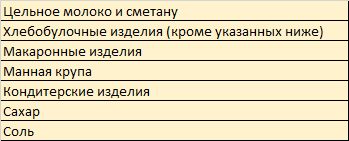
You can eat:
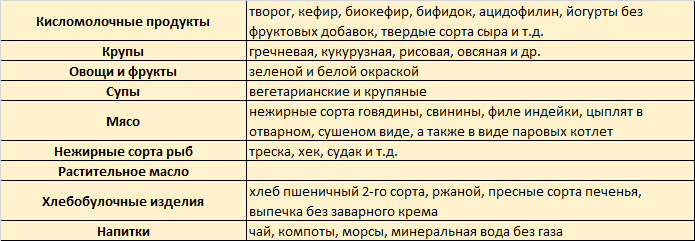
Treatment of allergies with drugs
Such an ailment, manifested by a rash, is treated using specially designed ointments and creams:

The processing of such lesions in infants in special ointments is well affected "Bepanten".
Also for the treatment of allergies in newborns, drops can be used:

To remove from the body, toxic substances, bacteria and other allergens can be used "Smecta".
Treatment of allergies in infants with folk remedies
Any types of allergies can be treated with traditional medicine recipes. But, it is important to understand that in no case can you engage in self -medication of children.

Herbal baths help to defeat the skin manifestations of such an ailment
- But, before their conduct, you need to make sure that the collections of herbs that are used to prepare such baths are not dangerous for your child
- For such purposes, oregano, dandelion, series and chamomile are brewed
- You can also take infusions and decoctions. The infusion of bay leaf (5 pcs) and rosehip berries (1 cup) has proven itself well. Give 4 times a day 1 tbsp. tablespoons
- Also for this purpose, you can use the leaves and branches of blackcurrant
Allergies prevention in children up to a year
- The best prevention of the described problem is prolonged breastfeeding. In this case, the mother must observe a strict diet. The complementary foods of children should be carried out no earlier than 5-6 months of life. At the same time, you need to start complementary foods with one-component cereals, one type of meat and 1-2 vegetables. So you can track and identify a product that contains allergens
- Children suffering from food allergies need to feed from 1/2 - 1/4 teaspoon, gradually increasing the volume
- It is advisable to include each new product in the diet a week after including the previous, "harmless" product
Tips and reviews
Katia. During the period of breastfeeding, you need to be patient and strictly observe a diet. Any of your whim can affect the child.
Vika. Read the labels. If the bank is written from a pear, then this does not mean that there is only a pear. There may be salt, sugar, starch and various additives.
